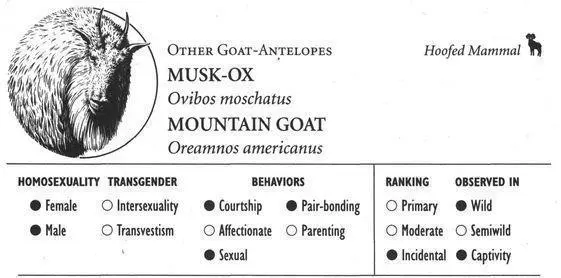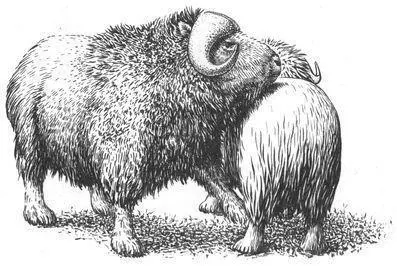Other Species
Same-sex courtship and mounting occur in several other species of wild sheep and goats, involving similar behavior patterns to those found in North American and European wild sheep. Among Bharal or Blue Sheep ( Pseudois nayaur ) of the Himalayas, 36–57 percent of mounting occurs between males (sometimes in huddles), while approximately 11 percent of courtship displays such as the low-stretch, twist, and foreleg kick are performed between males. Males also perform a “penis display” toward other males, in which the animal sometimes licks or sucks his own organ. Male Markhor (Capra falconeri) and Wild Goats or Bezoar (Capra aegagrus), two Central Asian species, also occasionally court and mount other males, as do male and female Aoudad or Barbary Sheep (Ammotragus lervia) of North Africa.
Sources
*asterisked references discuss homosexuality/transgender
*Berger, J. (1985) “Instances of Female-Like Behavior in a Male Ungulate.” Animal Behavior 33:333-35.
Demarchi, D. A., and H. B. Mitchell (1973) “The Chilcotin River Bighorn Population.” Canadian Field-Naturalist 87:433–54.
Festa-Bianchet, M. (1991) “The Social System of Bighorn Sheep: Grouping Patterns, Kinship, and Female Dominance Rank.” Animal Behavior 42:71–82.
*Geist, V. (1975) Mountain Sheep and Man in the Northern Wilds. Ithaca, N.Y.: Cornell University Press.
*———(1971) Mountain Sheep: A Study in Behavior and Evolution. Chicago: University of Chicago Press.
*———(1968) “On the Interrelation of External Appearance, Social Behavior, and Social Structure of Mountain Sheep.” Zeitschrift für Tierpsychologie 25:199–215.
*Habibi, K. (1987a) “Behavior of Aoudad ( Ammotragus lervia ) During the Rutting Season.” Mammalia 51: 497–513.
*———(1987b) “Overt Sexual Behavior Among Female Aoudads.” Southwestern Naturalist 32:148.
Hass, C. C. (1991) “Social Status in Female Bighorn Sheep (Ovis canadensis): Expression, Development, and Reproductive Correlates.” Journal of Zoology, London 225:509-23.
*Hass, C. C, and D. A. Jenni (1991) “Structure and Ontogeny of Dominance Relationships Among Bighorn Rams.” Canadian Journal of Zoology 69:471-76.
*Hogg, J. T. (1987) “Intrasexual Competition and Mate Choice in Rocky Mountain Bighorn Sheep.” Ethology 75:119–44.
———(1984) “Mating in Bighorn Sheep: Multiple Creative Male Strategies.” Science 225:526-29.
*Katz, I. (1949) “Behavioral Interactions in a Herd of Barbary Sheep ( Ammotragus lervia ).” Zoologica 34:9–18.
*McClelland, B. E. (1991) “Courtship and Agonistic Behavior in Mouflon Sheep.” Applied Animal Behavior Science 29:67-85.
*Pfeffer, P. (1967) “Le mouflon de Corse (Ovis ammon musimon, Schreber 1782). Position systématique, écologie, et éthologie comparées [The Mouflon of Corsica: Comparative Systematics, Ecology, and Ethology].” Mammalia (suppl.) 31:1–262.
*Schaller, G. B. (1977) Mountain Monarchs: Wild Sheep and Goats of the Himalaya. Chicago: University of Chicago Press.
*Schaller, G. B., and Z. B. Mirza (1974) “On the Behavior of Punjab Urial (Ovis orientalis punjabiensis ).” In V. Geist and F. Walther, eds. The Behavior of Ungulates and Its Relation to Management, vol. 1, pp. 306-23. IUCN Publication no. 24. Morges, Switzerland: International Union for Conservation of Nature and Natural Resources.
*Shackleton, D. M. (1991) “Social Maturation and Productivity in Bighorn Sheep: Are Young Males Incompetent?” Applied Animal Behavior Science 29: 173–84.
Valdez, R. (1990) “Oriental Wild Sheep.” In Grzimek’s Encyclopedia of Mammals, vol. 5, pp. 544–48. New York: McGraw-Hill.
*WiIson, P. (1984) “Aspects of Reproductive Behavior of Bharal (Pseudois nayaur) in Nepal.” Zeitschrift für Säugetierkunde 49:36–42.

MUSK-OX
IDENTIFICATION: A large (6–8-foot-long) mammal with long, shaggy fur, humped shoulders, and massive, down-sweeping horns. DISTRIBUTION: Arctic North America and Greenland. HABITAT: Tundra and meadows. STUDY AREAS: Nunivak Island, Alaska; Thelon Game Sanctuary, Northwest Territories, Canada; University of Saskatchewan; subspecies O.m. wardi and O.m. moschatus.
MOUNTAIN GOAT
IDENTIFICATION: A stocky, 3-foot-tall, goatlike mammal with shaggy white fur and sharp horns in both sexes. DISTRIBUTION: Western North America from southeastern Alaska to western Montana. HABITAT: Steep mountain slopes, cliffs. STUDY AREAS: Cassiar Mountain Range, British Columbia, Canada; Swan Mountains and Glacier National Park, Montana; Olympic National Park, Washington; subspecies O.a. americanus, O.a. columbiae, and O.a. missoulae.
Social Organization
Musk-oxen are generally social animals, living in mixed-sex herds (usually 10–20 animals) or smaller all-male groups; some males are also solitary. Male and female Mountain Goats remain largely segregated from each other for most of the summer, females associating in groups of usually less than 15 (including their offspring). Female Mountain Goats are generally dominant to males, who are solitary or peripheral to the female groups except during the rut. The mating system for both species is polygamous or promiscuous: animals copulate with several partners, and males do not participate in parenting.
Description
Behavioral Expression: Male Musk-oxen sometimes court and mount each other. Homosexual courtship involves several of the same patterns used in heterosexual interactions: POSITIONING, in which one male stands next to the other in a standard position such as perpendicular, parallel, or head-to-tail; SNIFFING OF THE REAR, in which one male smells and inspects the anal and genital region of the other; FORELEG KICKING, where one male gently swings his front leg against another male; and CHIN-RESTING, in which the courting male places his lower jaw on top of the other male’s body. Males also mount other males from behind (as in heterosexual mating). The mounted male sometimes resists (as do females when mounted by males) but may also permit himself to be mounted. Homosexual courtship and mounting both occur among younger males, while during the rutting season adult males sometimes court younger males as well (occasionally even juveniles). Adult male Musk-oxen may also form pairlike companionships that travel, graze, and spend time together (sometimes also fighting with one another), although overt courtship and sexual behavior probably does not occur between them.
A male Musk-ox courting another male with “foreleg kicking” and “chin-resting”

Adult male Mountain Goats court younger (yearling) males, again using the species-typical heterosexual behavior patterns: the courting male approaches the other in a crouching position, creeping on his stomach with his head stretched forward (a posture referred to as the LOW-STRETCH). He may also flick his tongue in and out of his mouth while making a soft buzzing sound, jerk his head sideways, and attempt to lick the other male’s flanks. Typically the yearling male responds aggressively to the courting adult. Adult males occasionally perform this display toward other adult males as well. In addition, yearling females sometimes mount their own mothers.
Читать дальше














